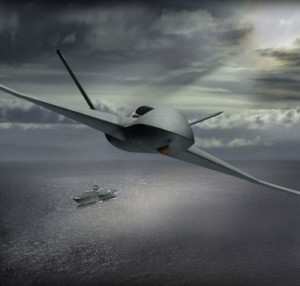GA-ASI Introduces "Sea Avenger" UAS for UCLASS Carrier
Operations
General Atomics Aeronautical Systems introduced Sea Avenger, a
carrier-based derivative of its Predator C Avenger UAS on Monday.
The aircraft was designed to fulfill the U.S. Navy's
stated need for an unmanned carrier-launched airborne
surveillance and strike (UCLASS) system. The company formally
proposed Sea Avenger to the Naval Air Systems Command (NAVAIR) via
a Request for Information (RFI) submitted on 30 April.

"Sea Avenger fulfills the Navy's need for a carrier-based
unmanned aircraft system that offers long-endurance, proven ISR
[Intelligence, Surveillance, and Reconnaissance] and
precision-strike capabilities," said Frank Pace, president,
Aircraft Systems Group, General Atomics Aeronautical Systems,
Inc.
Like Predator C Avenger, Sea Avenger presents a low-risk, high
technology ready procurement option as it leverages more than 18
years of Predator-series UAS development, manufacturing, and system
support, along with one million flight hours of operational
experience. In addition, many Predator-series elements,
components, and subsystems already provide mature, proven, and
affordable mission capabilities desired by the Navy for a UCLASS
system.
Anticipating a future requirement for a carrier-based UAS,
GA-ASI designed specific features into its Predator C Avenger to
facilitate subsequent development of an aircraft uniquely suitable
for carrier operations that would also integrate seamlessly into
the carrier air wing. These include a highly fuel-efficient
engine and inlet design, retractable electro-optical/infrared
(EO/IR) sensor, internal weapons bay, and folding wings. The
aircraft's structure was also designed with the flexibility to
accommodate carrier suitable landing gear, tail hook, drag devices,
and other provisions for carrier operations.
 "Sea Avenger is an affordable and
transformational technology that will provide commanders with
enhanced situational awareness and time-sensitive strike," noted J.
Neal Blue, chairman and CEO, General Atomics Aeronautical Systems,
Inc.
"Sea Avenger is an affordable and
transformational technology that will provide commanders with
enhanced situational awareness and time-sensitive strike," noted J.
Neal Blue, chairman and CEO, General Atomics Aeronautical Systems,
Inc.
Sea Avenger is based upon its predecessor, Predator C
Avenger. Predator C is designed to perform high-speed,
multi-mission persistent ISR and precision, time-sensitive strike
missions over land or sea. The current configuration features
a 44-foot long fuselage and 66-foot wingspan, is cable of flying at
400 KTAS for 20 hours, and can operate up to 50,000 feet.
Avenger incorporates a pure jet power plant and carries a Lynx
Synthetic Aperture Radar (SAR), various EO/IR camera systems, and
up to 3,000 pounds of internal ordnance, as well as other
sensors. The aircraft is based on an open, modular
architecture that provides "plug and play" system configuration,
configuration management, and significant flexibility for rapid,
controlled change, adaptation, and growth. Developed on
company funds for near-term military use, Predator C Avenger is
successfully continuing through its planned test program, with a
second aircraft currently under development and expected to be
completed by the end of the year.
 ANN's Daily Aero-Linx (05.02.24)
ANN's Daily Aero-Linx (05.02.24) ANN's Daily Aero-Term (05.02.24): Touchdown Zone Lighting
ANN's Daily Aero-Term (05.02.24): Touchdown Zone Lighting Aero-News: Quote of the Day (05.02.24)
Aero-News: Quote of the Day (05.02.24) ANN FAQ: Contributing To Aero-TV
ANN FAQ: Contributing To Aero-TV NTSB Final Report: Cirrus Design Corp SR20
NTSB Final Report: Cirrus Design Corp SR20




